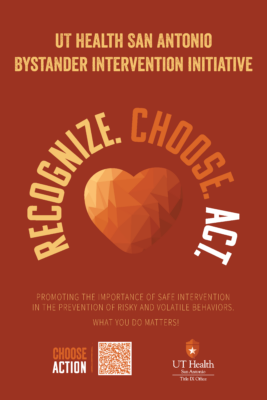The UT Health San Antonio’s Bystander Intervention Initiative aims to promote the importance of safe bystander intervention in the prevention of risky and volatile behaviors including sexual assault and relationship violence, to create a culture of caring for each other’s well-being.
What is Bystander Intervention?
Bystander intervention is recognizing a potentially harmful situation or interaction and choosing to respond in a way that could positively influence the outcome.
Bystander intervention is a philosophy and strategy for prevention of various types of violence, including bullying, sexual harassment, sexual assault, and intimate partner violence.
Why Bystander Intervention is Important
Bystander intervention can help to create a safer campus and empower students, faculty and staff to recognize and reduce harm. Empowering students, staff, and faculty to be active bystanders to help in ways, including:
- Minimizing the risk of sexual misconduct, sexual harassment, sexual assault and interpersonal violence such as domestic violence, dating violence, and stalking.
- Empowering individuals to recognize and respond to signs of in the prevention of risky behaviors.
- Creating a culture where hate speech, bias incidents, and harassment are not tolerated.
- Creating an inclusive environment for students with disabilities.
- Connecting individuals to important resources and services.
What are ways to engage in intervention? The 4 D’s
Direct – Respond directly or physically intervene if necessary and safe. Be confident, assertive, calm. Example: directly ask the person to stop their behavior.
Distract – Distraction is a subtle and creative way to intervene. Distract either the harasser or the target with conversation unrelated to the harassment to derail and de-escalate the situation. Examples: Ask for directions; Spill your drink “accidentally;” Pretend you know one of them.
Delegate – Obtain the assistance of another person, possibly someone in a position with more perceived authority. Examples: Alert a department manager, if in a club- a bouncer, or someone else to help intervene.
Delay – If you can’t intervene in the moment, you can check in with the person being harassed afterwards to see if you can do anything to support them. Examples: “Is everything okay? Is there anything I can do?” “Is there someone we can call?”



